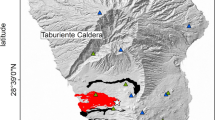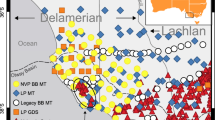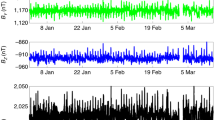Abstract
The ongoing collision of the Indian and Asian continents has created the Himalaya and Tibetan plateau through a range of deformation processes. These include crustal thickening, detachment of the lower lithosphere from the plate (delamination) and flow in a weakened lower crust1,2,3,4,5,6. Debate continues as to which of these processes are most significant7. In eastern Tibet, large-scale motion of the surface occurs, but the nature of deformation at depth remains unresolved. A large-scale crustal flow channel has been proposed as an explanation for regional uplift in eastern Tibet6,8,9, but existing geophysical data10,11 do not constrain the pattern of flow. Magnetotellurics uses naturally occurring electromagnetic waves to image the Earth’s subsurface. Here we present magnetotelluric data that image two major zones or channels of high electrical conductivity at a depth of 20-40 km. The channels extend horizontally more than 800 km from the Tibetan plateau into southwest China. The electrical properties of the channels imply an elevated fluid content consistent with a weak crust12,13 that permits flow on a geological timescale. These findings support the hypothesis that crustal flow can occur in orogenic belts and contribute to uplift of plateaux. Our results reveal the previously unknown complexities of these patterns of crustal flow.
This is a preview of subscription content, access via your institution
Access options
Subscribe to this journal
Receive 12 print issues and online access
$259.00 per year
only $21.58 per issue
Buy this article
- Purchase on Springer Link
- Instant access to full article PDF
Prices may be subject to local taxes which are calculated during checkout




Similar content being viewed by others
References
Tapponnier, P. et al. Oblique stepwise rise and growth of the Tibetan plateau. Science 294, 1671–1677 (2001).
Yin, A. & Harrison, T. M. Geologic evolution of the Himalayan–Tibetan orogen. Annu. Rev. Earth Planet. Sci. 28, 211–280 (2000).
DeCelles, P. G., Robinson, D. M. & Zandt, G. Implications of shortening in the Himalayan fold-thrust belt for uplift of the Tibetan plateau. Tectonics 21, 1062 (2002).
Beaumont, C., Jamieson, R. A., Nguyen, M. H. & Lee, B. Himalayan tectonics explained by extrusion of a low-viscosity crustal channel coupled to focused surface denudation. Nature 414, 738–742 (2001).
Klemperer, S. L. in Channel Flow, Ductile Extrusion and Exhumation in Continental Collision Zones Vol. 268 (eds Law, R. D., Searle, M. P. & Godin, L.) 39–70 (Geological Society, Special Publications, 2006).
Royden, L. H. et al. Surface deformation and lower crustal flow in eastern Tibet. Science 276, 788–790 (1997).
Replumaz, A. & Tapponnier, P. Reconstruction of the deformed collision zone between India and Asia by backward motion of lithospheric blocks. J. Geophys. Res. 108, 2285 (2003).
Clark, M. K. & Royden, L. H. Topographic ooze: Building the eastern margin of Tibet by lower crustal flow. Geology 28, 703–706 (2000).
Copley, A. & McKenzie, D. Models of crustal flow in the India–Asia collision zone. Geophys. J. Int. 169, 683–698 (2007).
Yao, H., Beghein, C. & van der Hilst, R. Surface wave array tomography in SE Tibet from ambient seismic noise and two-station analysis—II. Crustal and upper-mantle structure. Geophys. J. Int. 173, 205–219 (2008).
Xu, L., Rondenay, S. & van der Hilst, R. Structure of the crust beneath the southeastern Tibetan plateau from teleseismic receiver functions. Phys. Earth Planet. Inter. 165, 176–193 (2007).
Unsworth, M. J. et al. Crustal rheology of the Himalaya and southern Tibet inferred from magnetotelluric data. Nature 438, 78–81 (2005).
Rosenberg, C. L. & Handy, M. R. Experimental deformation of partially melted granite revisited: Implications for the continental crust. J. Metamorphic Geol. 555, 1–9 (2005).
Zhang, P. et al. Continuous deformation of the Tibetan plateau from global positioning system data. Geology 32, 809–812 (2004).
Sol, S. et al. Geodynamics of the southeastern Tibetan plateau from seismic anisotropy and geodesy. Geology 35, 563–566 (2007).
Unsworth, M. J. et al. Crustal and upper mantle structure of northern Tibet imaged with magnetotelluric data. J. Geophys. Res. 109, B02403 (2004).
Sun, J., Jin, G., Bai, D. & Wang, L. Sounding of electrical structure of the crust and upper mantle along the eastern border of Qinghai–Tibet plateau and its tectonic significance. Sci. China 46, 243–253 (2003).
McNeice, G. M. & Jones, A. G. Multisite, multifrequency tensor decomposition of magnetotelluric data. Geophysics 66, 158–173 (2001).
Rodi, W. & Mackie, R. L. Nonlinear conjugate gradients algorithm for 2D magnetotelluric inversion. Geophysics 66, 174–187 (2001).
Leloup, P. H. et al. New constraints on the structure, thermochronology and time of the Ailao Shan–Red River shear zone, Southeast Asia. J. Geophys. Res. 106, 6683–6732 (2001).
Hochstein, M. P. & Regenauer-Lieb, K. Heat generation associated with collision of two plates: The Himalayan geothermal belt. J. Volcanol. Geotherm. Res. 83, 75–92 (1998).
Li, S. et al. Partial melt or aqueous fluid in the mid-crust of southern Tibet? Constraints from INDEPTH magnetotelluric data. Geophys. J. Int. 153, 289–304 (2003).
Brasse, H. et al. The Bolivian Altiplano conductivity anomaly. J. Geophys. Res. 107, 2096 (2002).
Türkoğlu, E., Unsworth, M. J., Çağlar, l˙., Tuncer, V. & Avşar, Ü. Lithospheric structure of the Arabia–Eurasia collision zone in eastern Anatolia from magnetotelluric exploration: Evidence for widespread weakening by fluids. Geology 36, 619–622 (2008).
Nesbitt, B. Electrical resistivities of crustal fluids. J. Geophys. Res. 98, 4301–4310 (1993).
ten Grotenhuis, S. M., Drury, M. R., Spiers, C. J. & Peach, C. J. Melt distribution in olivine rocks based on electrical conductivity measurements. J. Geophys. Res. 110, B12201 (2005).
Rippe, D. & Unsworth, M. J. Quantifying crustal flow in Tibet with magnetotelluric data. Phys. Earth Planet. Inter. 179, 107–121 (2010).
Tullis, J., Yund, R. & Farver, J. Deformation enhanced fluid distribution in feldspar aggregates and implications for ductile shear zones. Geology 24, 63–66 (1996).
Teyssier, C., Whitney, D. L & Rey, P. F. The rheologic implications of partial melting in Continental plateaux. Eos. Trans. AGU (Fall Meeting Suppl.) 90, abstr. T32C-07 (2009).
Burchfiel, B. C. et al. A geological and geophysical context for the Wenchuan earthquake of 12 May 2008, Sichuan, People’s Republic of China. GSA Today 18, 4–11 (2008).
Acknowledgements
The authors thank Z. J. Ma, Q. D. Deng, Y. P. Wang and D. L. Zhong for their encouragement and valuable discussions. Project EHS3D is sponsored by the China National Science Foundation grants, No. 40634025, 40374034. Reviews by M. Leech, R. Law and P. Wannamaker significantly improved this manuscript and are greatly appreciated. We thank G. McNeice and A. G. Jones for the use of their decomposition software.
Author information
Authors and Affiliations
Contributions
D.B. designed the project, collected and interpreted data and wrote the paper. M.J.U. processed and interpreted data and wrote the paper. M.A.M. designed the project, interpreted data and wrote the paper. X.M. and Y.S. designed the project and processed data. J.T., X.K., J.S. and C.J. designed the project and interpreted data. L.W. and C.Z. designed the project and collected data. P.X. and M.L. collected the data.
Corresponding author
Ethics declarations
Competing interests
The authors declare no competing financial interests.
Supplementary information
Supplementary Information
Supplementary Information (PDF 767 kb)
Rights and permissions
About this article
Cite this article
Bai, D., Unsworth, M., Meju, M. et al. Crustal deformation of the eastern Tibetan plateau revealed by magnetotelluric imaging. Nature Geosci 3, 358–362 (2010). https://doi.org/10.1038/ngeo830
Received:
Accepted:
Published:
Issue Date:
DOI: https://doi.org/10.1038/ngeo830
This article is cited by
-
Formation of the Tibetan Plateau during the India-Eurasia Convergence: Insight from 3-D Multi-Terrane Thermomechanical Modeling
Journal of Earth Science (2024)
-
Enormously large tippers observed in southwest China: can realistic 3-D EM modeling reproduce them?
Earth, Planets and Space (2023)
-
Two Unconnected Low-Velocity Zones in the Eastern Boundary of the Sichuan-Yunnan Block Revealed with High-Resolution Ambient Noise Tomography
Pure and Applied Geophysics (2023)
-
Uncertainty Quantification and Field Source Inversion for the Continental-Scale Time-Varying Gravity Dataset: A Case Study in SE Tibet, China
Pure and Applied Geophysics (2023)
-
Upper-Mantle Velocity Heterogeneity of Eastern Tibetan Plateau from Teleseismic P-Wave Tomography and Its Tectonic Implications
Journal of Earth Science (2023)



